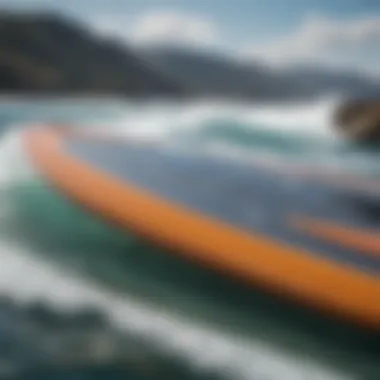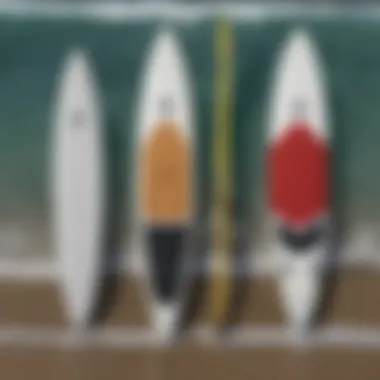Ultimate Guide to Purchasing Hydrofoil Surfboards


Intro
As the surfing community evolves, the rise of hydrofoil surfboards marks a significant shift in how enthusiasts interact with the waves. Hydrofoil surfboards stand apart from their traditional counterparts through their unique design and capabilities, offering an exhilarating experience that many surfers are eager to explore. This guide lays out a clear blueprint for navigating your purchase of a hydrofoil surfboard.
Understanding the difference between hydrofoils and standard surfboards is crucial. While traditional boards keep you skimming over the water's surface, hydrofoils allow you to rise above the waves, reducing drag and allowing for smoother rides, particularly in smaller swells. Such a shift calls for a thorough examination not only of the board itself but also of the technology behind it, the techniques that optimize its use, and the maintenance required to keep it performing at its best.
Whether you're a seasoned board rider or just dipping your toes in the water, acquiring sound knowledge about what makes a hydrofoil surfboard tick is imperative. This article will guide you through critical aspects, from selecting the right board to mastering the art of hydrofoil surfing are essential for getting the most out of your investment. Armed with this information, you'll be well-prepared to make an informed choice suited to your level and aspirations.
Let's dive deeper into techniques specific to hydrofoil surfing and how to enhance your riding skills, as these considerations can significantly affect your purchasing decision.
Understanding Hydrofoil Surfboards
Navigating the world of hydrofoil surfboards is essential for anyone looking to elevate their ride. These boards bring a unique twist to the surfing experience, allowing riders to glide above the water's surface, reducing drag and enhancing performance. Understanding the mechanics and benefits of hydrofoil surfboards can significantly influence your purchase decision and overall enjoyment on the water.
What is a Hydrofoil Surfboard?
A hydrofoil surfboard is essentially a surfboard equipped with a hydrofoil, which comprises two main parts: the wing and the mast. The wing sits submerged beneath the water, while the mast connects it to the board above. As the board gains speed, the hydrofoil creates lift, lifting the board out of the water and allowing it to glide effortlessly. This means less resistance and smoother rides, even in choppy conditions.
For many, the initial sight of a hydrofoil surfboard conjures up images of futuristic technology and thrilling rides. It's not just about surfing; it's an entirely new way to interact with water. These boards are gaining traction among kiteboarders and windsurfers as they open up new possibilities in terms of speed and maneuverability.
How Hydrofoils Work
Understanding how hydrofoils work is crucial for maximizing their potential. When a hydrofoil surfboard picks up speed, water flows over the foil's wing, creating an area of low pressure above the wing. This pressure difference generates lift. As the board ascends, the reduced contact with the water diminishes drag, allowing for increased speed and smoother turns.
To break it down simply:
- Lift is generated as speed increases.
- Less contact with the water means less drag.
- The rider can maneuver with ease, making quick turns and adjustments.
Getting a firm grasp of the mechanics can significantly change how one approaches riding the hydrofoil. New riders must be aware of the balance required; controlling the elevation is key. Too much lift can lead to a nose dive, while too little can bring the board crashing down into the water.
Advantages Over Traditional Surfboards
Hydrofoil surfboards come with a host of benefits that can redefine one's ocean experience:
- Less Drag: With a hydrofoil surfboard, you'll notice less drag compared to traditional boards. The ability to glide on the surface transforms the ride.
- Extended Season: Riders can tackle various surf conditions with greater ease, extending their surfing season, as these boards perform well in smaller waves where traditional boards might struggle.
- Unique Thrills: There’s a distinct rush that comes with flying above the water. While traditional surfing offers its thrills, hydrofoiling adds a level of excitement that captures the imagination of riders and onlookers alike.
- Versatility: Hydrofoils aren’t just for surfing; they can be used for kitesurfing and wakeboarding as well. This adaptability makes them a worthwhile investment.
Ultimately, understanding hydrofoil surfboards allows enthusiasts to make informed choices, whether they're in the market for their first board or looking to upgrade. From grasping the mechanics to appreciating the advantages, this foundational knowledge sets the stage for a successful surfing journey.
Key Considerations When Buying a Hydrofoil Surfboard
When diving into the world of hydrofoil surfboards, several key factors need to be thoughtfully weighed before making a purchase. Understanding these considerations can mean the difference between an exhilarating ride and a frustrating one. This section breaks down the critical elements that should inform your buying decision, leading to a more satisfactory surf experience.
Skill Level Assessment
Assessing your skill level is paramount when selecting a hydrofoil surfboard. This isn’t just about whether you can keep your balance; it’s about understanding your comfort zone and pushing your boundaries.
For beginners, it’s essential to choose a board that offers stability and ease of use. A larger board with a wider foil can help you find your feet on the water without the fear of nosediving or falling off. On the other hand, experienced riders may prefer something more agile, perhaps a smaller board with a specialized design that allows for sharper turns and more complex maneuvers.


"Choosing a board that complements your skills not only improves your performance but also enhances the joy of learning."
So, take a good hard look in the mirror and be honest about where you stand. Do you feel like a fish out of water or are you catching waves like a pro? Your answers will guide your choice significantly.
Board Size and Shape
The size and shape of a hydrofoil surfboard are critical to its performance. Boards come in various sizes, and each has its application depending on the rider's weight, skill, and intended use. A larger board tends to be more stable and easier to control, especially for those new to foiling—think of it as the training wheels on a bike.
Conversely, if you're more skilled, you might lean toward a shorter board that allows for sharper turns and a livelier ride. The shape also plays a role; wide boards tend to offer more lift, which is beneficial in smaller waves, while narrower boards can reduce drag, enhancing speed.
When choosing your board, consider:
- Weight capacity
- Wave conditions
- Personal comfort level
Foil Design and Material
Next up is the foil itself, which is often overlooked but incredibly significant. Pay attention to the design and material of the foil, as these characteristics affect lift and performance. Foils can be made of aluminum, carbon fiber, or a combination of both.
- Aluminum Foils: Generally more affordable and durable, making them suitable for beginners.
- Carbon Fiber Foils: These are lightweight and efficient, ideal for performance-oriented riders.
The profile of the foil also matters; different shapes can influence how high you can ride above the water and the speed you can achieve. As a rule of thumb, if you're looking to catch air and perform tricks, a thinner profile might serve you better.
Budget and Cost Factors
Finally, let’s talk money. Hydrofoil surfboards can vary wildly in price, and understanding your budget before you start shopping is wise. Premium brands may have higher price tags due to advanced materials and designs, which could contribute to better performance.
However, just because a board costs more doesn’t mean it's better for your needs. Consider the following when evaluating cost:
- Long-term investment: If you plan to use it extensively, investing in a quality board may save you in replacement costs down the road.
- Used market: Sometimes, a gently used hydrofoil can offer the best compromise between quality and cost. Look out for reliable sellers.
A well-structured budget also lets you know when to splurge on essentials without putting you into a tight spot.\
In summary, when buying a hydrofoil surfboard, assess your skill level, consider board size and shape, examine foil design and materials, and keep an eye on your budget. Making informed decisions in these areas will undoubtedly set the stage for a successful journey into hydrofoiling.
Popular Brands and Models
The choice of hydrofoil surfboard can make or break your experience on the waters. Recognizing the leading brands and models can guide potential buyers toward making choices that best suit their riding style, skill levels, and budget. With the ever-evolving tech behind hydrofoils and varying designs, being aware of reputable brands and standout models is crucial. This section highlights some top names in the industry, catering to both novices and seasoned riders.
Top Hydrofoil Surfboard Brands
In the hydrofoil market, several brands have established themselves as frontrunners by consistently delivering quality products. Familiarity with top brands not only eases the decision-making process but also instills confidence in the reliability of your purchase. Here are some noteworthy brands:
- Naish: Renowned for innovation and performance, Naish offers a range of hydrofoil boards designed to maximize speed and maneuverability.
- Slingshot: Their boards are built rugged and often feature unique designs that cater to a variety of skill levels.
- Armstrong Foils: Specializing in high-performance hydrofoils, Armstrong is well-regarded among experienced riders who appreciate precision engineering.
- Lift Foils: They are known for their lightweight constructions, helping riders achieve optimal performance and ease of control.
Choosing a board from a reputable manufacturer means you’re investing in quality craftsmanship and cutting-edge technology, both of which can significantly enhance your riding experience.
Best Models for Beginners
For those just starting out, selecting the right model can significantly influence the learning curve. It’s important to focus on stability, buoyancy, and ease of handling. Here are some solid options suitable for newcomers:


- Naish Hover: Designed with a generous volume, the Hover ensures beginners can catch waves easily while providing great stability.
- Slingshot Phantom: This board is perfect for new riders looking for a forgiving platform as they familiarize themselves with hydrofoiling.
- Lift Foils E-Foil: Although on the pricier side, this model is electric-powered, making it easier for beginners to get accustomed to riding without battling waves.
Opting for boards like these aids in developing skills without overwhelming new riders, encouraging confidence and enjoyment during practice.
Advanced Options for Experienced Riders
Once mastery over the basics is achieved, riders often seek boards that push their limits and broaden their horizons. Advanced riders tend to appreciate versatility in their gear, allowing them to perform tricks and tackle different conditions. Here are top recommendations:
- Armstrong | A+: Built for speed and agility, this board is fantastic for those who want to test their skills further and learn more complicated maneuvers.
- Naish Thrust: Featuring adaptable foil concepts, it provides experienced riders with the tools they need to excel on big waves while maintaining control.
- Slingshot Infinity: Known for exceptional glide and efficiency, the Infinity combines speed with stability, ideal for those who excel in variable conditions.
Selecting from advanced options helps riders refine their technique, tackle challenging surf, and explore the full potential of hydrofoiling as an exciting sport.
"Investing in the right hydrofoil can not just boost your skills, but also ignite your passion for riding. Reputable brands and carefully selected models play a big role in this journey."
Understanding the significance of popular brands and models lays a solid foundation for buyers, ensuring they make informed choices tailored to their unique riding preferences.
Buying Options and Where to Purchase
When it comes to buying a hydrofoil surfboard, understanding the various purchasing options is not just a convenience; it's a significant factor in ensuring you get the best fit for your surfing needs. Owning a hydrofoil board can be quite an investment, so knowing where to make that purchase can impact everything from cost to customer support. Whether you're a newcomer or an experienced surfer, grasping the nuances of your buying options helps facilitate an informed decision.
Local Retailers vs. Online Stores
In the world of hydrofoil surfboards, two main purchasing paths stand out: local retailers and online stores. Each has its own distinct advantages and pitfalls that can influence your buying experience.
Buying from local retailers offers the undeniable perk of physically inspecting the board. This tactile experience can make a world of difference in ensuring you're making the right choice. You can feel the weight, test the flexibility, and sometimes even demo the product on-site. Local shops also provide opportunities for face-to-face interactions with knowledgeable staff, who can offer insights that might not come across in a product description.
However, local shops often have a limited selection. You may find it challenging to source various brands or specific models. Besides, prices at retail locations can sometimes be higher due to overhead costs. In small communities, the expertise may also vary greatly.
On the flip side, online stores present a vast array of options that can cater to virtually any preference. Websites might boast extensive catalogs featuring the latest models and often provide competitive pricing as well. It's also easier to compare multiple vendors, read customer reviews, and find out which products truly perform well under different conditions.
Nevertheless, buying online has its downsides. You can't physically feel the board, which can lead to uncertainty. Delays in shipping can make receiving your gear an exercise in patience, and returns may become a hassle if you end up with something that doesn’t meet your expectations.
Evaluating Vendor Reputation
Regardless of your purchasing channel, evaluating the vendor's reputation is paramount. A reputable vendor not only assures quality goods but also provides customer service that can ease post-purchase questions or complications. Engage with online forums or social media groups related to hydrofoil surfing, like those found on platforms such as reddit.com, to gather insights and feedback about your chosen vendor.
Look for vendors with established return policies and warranties. These safety nets can protect your investment, especially since hydrofoil boards can be pricey. Reading customer reviews is essential, but context matters; a single negative review should not taint your view unless it appears frequently or reflects an ongoing issue.
"In an industry like surfing, where customer experience can vary greatly, vendor reputation is your best ally for a smooth transaction."
Second-Hand Market Considerations
The second-hand market can be a treasure trove of great deals. Surfboard enthusiasts often find quality hydrofoil boards at a fraction of the original price. However, it requires more due diligence than purchasing new.
Inspect the board closely before any transaction. Look for signs of wear, such as deep scratches or repairs. Don’t hesitate to ask for detailed photographs if buying online. Trustworthy sellers should be transparent about the condition of the board they are selling. Always inquire about the board's history: Has it ever been damaged? How frequently was it used?
Additionally, check the foil attachments, as these are just as important as the board itself. Outdated or damaged foils could entirely negate the benefits of buying second-hand.
Another tip: when engaging with second-hand sellers, see if they are well-reviewed on platforms like facebook.com or specific surf communities. This can help ensure you're not just exchanging cash for a potential headache.


Ultimately, whether you choose to shop locally, explore online stores, or dive into the second-hand market, being armed with knowledge will aid in making a choice that aligns with your surfing aspirations.
Performance Tips for New Owners
When you take the leap into hydrofoil surfing, knowing how to perform effectively on your board can make all the difference. Getting accustomed to these boards can be quite a tricky business, so gathering a slew of performance tips is paramount for newcomers. These guidelines not only help optimize your experience, but they also ensure you get the most out of your investment. Diving into these hints will help you ride the waves with confidence and finesse.
Initial Setup and Adjustments
Getting your hydrofoil surfboard set up correctly is the first step toward a successful riding experience. Each board has its own foiling characteristics, and it's crucial to make the right adjustments from the start.
- Positioning the Foil: Begin by determining the right distance of the foil from the tail of the board. A common approach is to start with the foil set around 10 to 12 inches from the back. If you're more advanced, you might experiment with moving it either forward or backward, depending on your style of riding.
- Footstrap Placement: Depending on your comfort and skill level, adjust the footstraps so you can optimize control. A wider stance generally allows for better stability but can feel a bit awkward at first. Stay patient and give your foot placement some thought – it’ll pay off later.
- Board Angle and Elevation: Once you’re out on the water, pay attention to how your board interacts with the water’s surface. Adjusting the angle of the front of your board can affect how easily it lifts. Remember: a slight tilt down will enhance lift, while a flatter board will help with stability.
Proper set up can make a world of difference when it comes to minimizing early frustrations and enhancing your overall ride.
Riding Techniques for Stability
Achieving stability while riding a hydrofoil surfboard requires a unique set of techniques. Unlike traditional surfing, hydrofoils demand careful balance and rhythm.
- Center Your Weight: When riding, keep your weight centered over the board, avoiding leaning too far back or forward. This balance helps maintain an optimal edge, thus preventing the foil from diving back into the water.
- Knees Slightly Bent: If you keep your knees bent, this stance can absorb turbulence or unexpected bumps. A flexible posture allows you to react quickly to shifts in momentum.
- Focus on Your Gaze: Keep your eyes looking ahead rather than down at your board. This method helps maintain balance and prepares you for potential waves or other riders approaching.
- Transitioning Techniques: As you turn, shift your weight gradually rather than making abrupt movements. This technique creates a smooth transition, allowing the foil to maintain its lift and glide.
The right riding technique won't just enhance your comfort; it can also be the difference between a pleasant ride and an unwanted tumble.
Maintenance for Longevity
Maintaining your hydrofoil surfboard is crucial for preserving its performance and ensuring it lasts through the years. After all, a well-cared-for board can provide countless thrilling rides!
- Regular Inspection: After each session, check the foil for any signs of wear, such as scratches or dents. Inspecting the board after each use can help catch issues early on.
- Cleaning: Rinse your board with fresh water after every use, especially if you've ridden in salty seawater. Removing salt and debris helps prevent deterioration and keeps your board in prime condition.
- Storage Tips: Keep your board in a cool, dry place when not in use. Avoid leaving it exposed to direct sunlight or extreme temperatures; these conditions can warp the materials over time.
- Professional Servicing: If you notice any damages or want to ensure everything is in tip-top shape, consider booking a session with a professional or reaching out to the manufacturer for guidance.
Neglecting maintenance can lead to costly repairs down the line, so staying on top of this task can enhance not just performance but your overall surfing experience as well.
Takeaway: Following these performance tips is essential for maximizing the potential of your hydrofoil surfboard, empowering you from the initial setup through your riding journey.
Frequently Asked Questions
Understanding hydrofoil surfboards come with its fair share of queries. This section aims to dissect common concerns and address them thoughtfully. By providing clear answers to frequently asked questions, readers can alleviate uncertainties and gain confidence in their decision-making process. Addressing these concerns offers clarity about the product and its use, and ensures readers feel well-equipped to enter this new realm of surfing.
Common Concerns About Hydrofoil Surfboards
Many enthusiasts and newcomers alike wonder about the complexities of hydrofoil surfboards. Some prevalent concerns include:
- Safety Measures: What safety precautions should one take while using a hydrofoil surfboard? Being elevated above water can seem risky, and many worry about getting injured, especially when learning the ropes.
- Weight Limitations: Do hydrofoil surfboards have specific weight restrictions? Understanding the board's structure and design ensures you choose one that suits your body type.
- Learning Curve: How long does it typically take to master hydrofoiling? Many novices fear they might struggle to balance on the board and rise above the water efficiently.
- Storage and Portability: Are hydrofoil surfboards cumbersome when transporting? Enthusiasts often seek a balance between performance and practicality.
To put these concerns at ease:
Hydrofoils are designed with stability in mind, and proper safety gear enhances your experience.
Being aware and prepared goes a long way in ensuring not only an enjoyable ride but also a safe one. The emphasis should be on understanding that with practice, many of these concerns can be managed.
Tips for Overcoming Learning Curves
Navigating the waters of hydrofoiling might feel as daunting as learning to ride a bike for the first time. But there are some effective strategies to ease the transition:
- Start on Calm Water: Begin practicing in flat, calm conditions to focus on balancing and getting comfortable with your board's movements. This lowers the chance of falling and helps build confidence.
- Take Introductory Lessons: Seeking guidance from seasoned instructors can provide insight and techniques that self-taught individuals might overlook. It speeds up the learning process drastically.
- Use a Bigger Board: For beginners, opting for a larger board can enhance stability. Bigger boards are typically easier to control and provide more support as you learn.
- Practice Regularly: Consistency is key. Aim to ride as often as you can to familiarize yourself with the sensations involved and build muscle memory.
By focusing on these practical approaches, you can mitigate anxiety related to learning and soak in the joy that hydrofoiling brings. There's nothing quite like the feeling of gliding above the waves after a bit of dedication.







